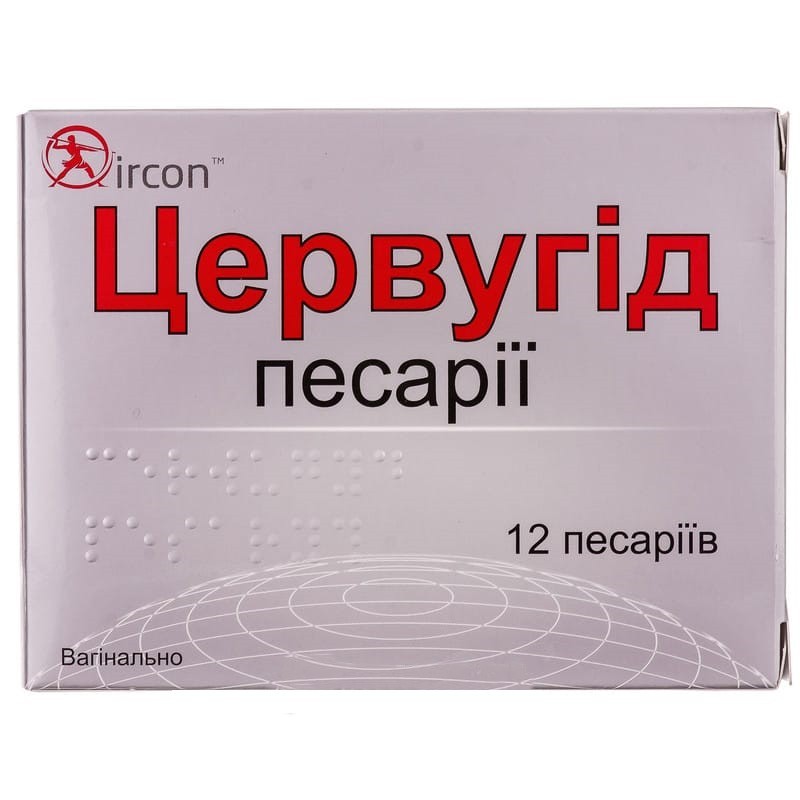



 Secure and encrypted payment processing
Secure and encrypted payment processing We ship to over 40 countries including the USA, UK, Europe, Australia and Japan
We ship to over 40 countries including the USA, UK, Europe, Australia and Japan Guaranteed refund or reship if you haven't received your order
Guaranteed refund or reship if you haven't received your orderCervugide pessaries for the treatment of vaginitis and cervicitis caused by various types of bacteria and microorganisms; treatment of fungal vaginitis caused by Candida spp. in combination with other types of microorganisms.
Treatment of pathogenic flora for sampling of the smear for the Babes-Papanicolaou cytotest in order to refine the microscopic field and improve the interpretation of the cytotest.
Prevention of vaginitis and cervicitis in patients who will undergo surgical or diagnostic intervention in the genital area.
Active ingredients in one pessary: chloramphenicol, metronidazole, nystatin, hydrocortisone acetate, chloramphenicol 200 mg, metronidazole 500 mg, nystatin 660000 mo, hydrocortisone acetate 15 mg.
Excipients: vitepsol H15.
Hypersensitivity to any active substances and excipients.
Acute hepatic or renal failure.
Severe hematological disorders.
Pregnancy and lactation.
The recommended daily dose for all therapeutic indications is 1 pessary per day, administered in the evening, before bedtime.
The duration of treatment is 7 days.
In case of ulcerative cervicitis, repeat the course 1 or 2 times while there are scars, with a break of 7 days between periods of use.
In the case of vaginitis and cervicitis caused by severe inflammatory diseases of infectious origin.
The potential risk to humans is unknown. Cervugide should not be used during pregnancy.
Cervugide is used to treat children from the age of 14 years.
No cases of overdose have been reported.
After the first dose, erythema, local burning sensation may occur.
Local reactions: sometimes burning, pain, itching, irritation of the vaginal mucosa.
System effects : as with any local application, absorption of a small amount of the drug is possible.
Gastrointestinal tract: nausea, diarrhea, cramping pain in the lower abdomen, epigastric pain, vomiting, inflammation of the oral mucosa, taste disturbances, anorexia, very rarely - pancreatitis, which are reversible.
central nervous system: peripheral sensory neuropathy, headache, cramps, dizziness, encephalopathy and subacute cerebellar syndrome, which may occur after discontinuation of the drug, psychotic disorders, including confusion, hallucinations.
Vision: temporary visual impairment, such as diplopia, myopia.
Skin and subcutaneous tissue: rash, itching, burning of the vagina, redness of the skin, urticaria, pustular rashes, atrophy of the subcutaneous tissue, erythema, dryness.
Immune system: fever, angioedema, anaphylactic shock.
From the side to the ditch and the lymphatic system: leukopenia, agranulocytosis, neutropenia and thrombocytopenia.
Hepatobiliary system : abnormal liver function tests, which are reversible, cholestatic hepatitis.
During treatment, urine may acquire a red-brown color, which is due to the presence of water-soluble pigments, which are a product of metronidazole metabolism.
You should not drink alcoholic beverages and take drugs containing alcohol during treatment and for at least one more day after its end due to the possible occurrence of a disulfiram-like reaction: the effect of antabuse, sensation of heat, redness of the face, vomiting, tachycardia.
Metronidazole can increase plasma levels of busulfan, which can lead to significant toxic effects of busulfan.
Cyclosporin - there is a risk of increased levels of cyclosporin in the blood serum.If drugs must be taken at the same time, cyclosporin and creatinine levels should be carefully monitored.
Phenytoin or phenobarbital - causes a decrease in plasma metronidazole levels.
Shelf life 2 years.
Store in the original packaging at a temperature not exceeding 25 ° C.
Keep out of the reach of children.